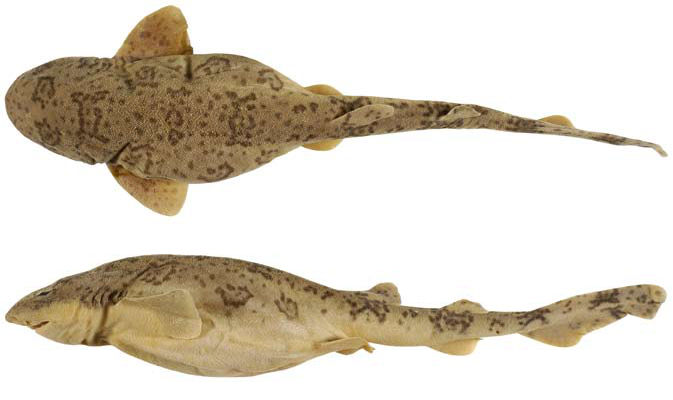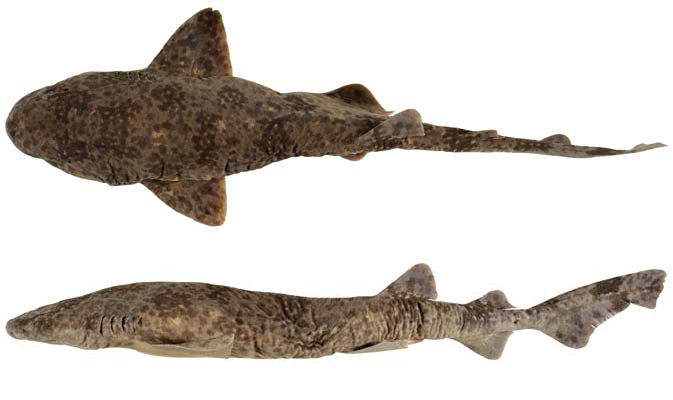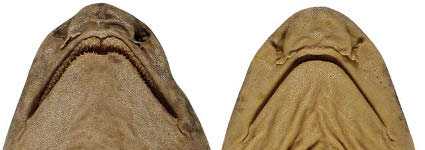Cephaloscyllium speccum
Last, Séret & White, 2008
Speckled swellshark
Classification: Elasmobranchii Carcharhiniformes Scyliorhinidae
Reference of the original description
New swellsharks (Cephaloscyllium: Scyliorhinidae) from the Indo-Australian region. CSIRO Marine and Atmospheric Research Paper, 22, 129–146
New swellsharks (Cephaloscyllium: Scyliorhinidae) from the Indo-Australian region. CSIRO Marine and Atmospheric Research Paper, 22, 129–146
Image of the original description

Cephaloscyllium speccum sp. nov.: dorsal view, lateral view of juvenile paratype (CSIRO H 1636–01, male 330 mm TL). In: Last, P.R. & Séret, B. & White, W.T. (2008): New swellsharks (Cephaloscyllium: Scyliorhinidae) from the Indo-Australian region. CSIRO Marine and Atmospheric Research Paper, 22: 129-146

Cephaloscyllium speccum sp. nov.: dorsal view, lateral view of juvenile paratype (CSIRO H 1636–01, male 330 mm TL). In: Last, P.R. & Séret, B. & White, W.T. (2008): New swellsharks (Cephaloscyllium: Scyliorhinidae) from the Indo-Australian region. CSIRO Marine and Atmospheric Research Paper, 22: 129-146
Synonyms / new combinations and misspellings
Cephaloscyllium cf. speccum
Cephaloscyllium cf. speccum
Types
Cephaloscyllium speccum
Holotype: WAM: P.31317-001; Paratype: CSIRO: H 1210-01; CSIRO: H 1634-01; CSIRO: H 1636-01; CSIRO: H 2027-01; CSIRO: CA 4109; WAM: P.28272-001;
Cephaloscyllium speccum
Holotype: WAM: P.31317-001; Paratype: CSIRO: H 1210-01; CSIRO: H 1634-01; CSIRO: H 1636-01; CSIRO: H 2027-01; CSIRO: CA 4109; WAM: P.28272-001;
Description :
Citation: Cephaloscyllium speccum Last, Séret & White, 2008: In: Database of modern sharks, rays and chimaeras, www.shark-references.com, World Wide Web electronic publication, Version 01/2026
Please send your images of "Cephaloscyllium speccum" to info@shark-references.com

Cephaloscyllium speccum sp. nov.: dorsal view, lateral view of holotype (WAM P 31317–001, adult male 680 mm TL); In: Last, P.R. & Séret, B. & White, W.T. (2008): New swellsharks (Cephaloscyllium: Scyliorhinidae) from the Indo-Australian region. CSIRO Marine and Atmospheric Research Paper, 22: 129-146

Cephaloscyllium speccum sp. nov.: dorsal view, lateral view of holotype (WAM P 31317–001, adult male 680 mm TL); In: Last, P.R. & Séret, B. & White, W.T. (2008): New swellsharks (Cephaloscyllium: Scyliorhinidae) from the Indo-Australian region. CSIRO Marine and Atmospheric Research Paper, 22: 129-146
Common names
 Speckled swellshark
Speckled swellshark
 Speckled swellshark
Speckled swellshark
Short Description
A medium-sized species with the following characters: head 7.8-12.5% TL in height, trunk width 13.0-16.8% TL; origin of first dorsal-fin mostly over posterior of pelvic-fin base; prenarial 3.6-4.9% TL in length; preorbital snout length 1.5-2.0 times prenarial length, 2.6-3.1 in prepectoral length, 5.9-7.1 in prepelvic length; snout-vent length long, 47.4-51.1% TL; nostril 2.2-2.7% TL in width; eye-spiracle space narrow, 0.4-1.0% TL; pectoral fin medium-sized, height 8.9-13.8% TL, posterior margin 8.5-13.3% TL; anal fin tall, 3.2-4.4% TL; anal-caudal space 4.5-6.1% TL; precaudal 76-78% TL in length; interdorsal space 6.5-8.6% TL; adult clasper long, outer length about 7% TL, well short of anal fin, interspace about 1.9% TL; vertebral centra 111-115; tooth count relatively high, 69-97 teeth in each jaw; color of upper half of body pale, with a strongly variegated pattern that is well-demarcated from the ventral surface; dark saddles (8) evident on body and caudal fin; pale variegated dorsal fins; dark blotch over gills absent; distinct V-shaped marking on posterior margin of terminal lobe of caudal fin absent; upper surfaces of pectoral and pelvic-fin without a dark central blotch; without dark saddle extending onto caudal peduncle above origin of ventral lobe of caudal fin; uniformly pale on the ventral surface; color of juveniles pale, with dark lines and spots forming rosettes and linear saddle markings, and the markings between spiracles separated into two unconnected pseudo-ocelli [3340].
A medium-sized species with the following characters: head 7.8-12.5% TL in height, trunk width 13.0-16.8% TL; origin of first dorsal-fin mostly over posterior of pelvic-fin base; prenarial 3.6-4.9% TL in length; preorbital snout length 1.5-2.0 times prenarial length, 2.6-3.1 in prepectoral length, 5.9-7.1 in prepelvic length; snout-vent length long, 47.4-51.1% TL; nostril 2.2-2.7% TL in width; eye-spiracle space narrow, 0.4-1.0% TL; pectoral fin medium-sized, height 8.9-13.8% TL, posterior margin 8.5-13.3% TL; anal fin tall, 3.2-4.4% TL; anal-caudal space 4.5-6.1% TL; precaudal 76-78% TL in length; interdorsal space 6.5-8.6% TL; adult clasper long, outer length about 7% TL, well short of anal fin, interspace about 1.9% TL; vertebral centra 111-115; tooth count relatively high, 69-97 teeth in each jaw; color of upper half of body pale, with a strongly variegated pattern that is well-demarcated from the ventral surface; dark saddles (8) evident on body and caudal fin; pale variegated dorsal fins; dark blotch over gills absent; distinct V-shaped marking on posterior margin of terminal lobe of caudal fin absent; upper surfaces of pectoral and pelvic-fin without a dark central blotch; without dark saddle extending onto caudal peduncle above origin of ventral lobe of caudal fin; uniformly pale on the ventral surface; color of juveniles pale, with dark lines and spots forming rosettes and linear saddle markings, and the markings between spiracles separated into two unconnected pseudo-ocelli [3340].
Dentition
teeth have 3-5 cusps; unicuspidate or weakly tricuspidate flank denticles; back with no greatly enlarged denticles [3340].
teeth have 3-5 cusps; unicuspidate or weakly tricuspidate flank denticles; back with no greatly enlarged denticles [3340].
Remarks
shark-references Species-ID=1315;
shark-references Species-ID=1315;

















